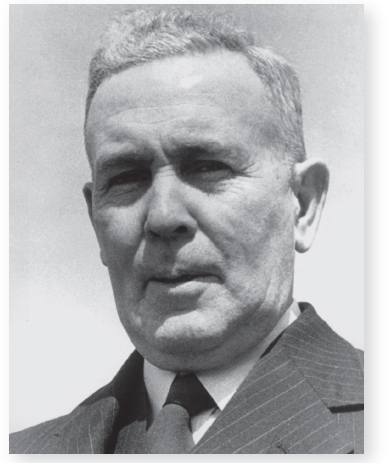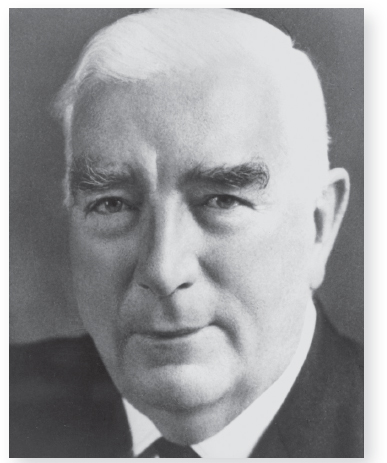First Among Equals (7 page)
Read First Among Equals Online
Authors: Kim; Derry Hogue; Wildman

FRANCIS MICHAEL FORDE
THE COUNTRY'S SHORTEST-SERVING PRIME MINISTER
TERM
6 July 1945-13 July 1945
E
ven though he served as prime minister for only eight days, Francis Michael Forde is much more than a footnote in Australian political history. A federal parliamentarian for 24 years, Forde was a hardworking âmasterly politician' who was deeply loyal to the Labor Party.
The second of six children, Forde was born in Mitchell in south-west Queensland on 18 July 1890. After attending primary school in Mitchell, he became a boarder at the Christian Brothers' College in Toowoomba where he trained as a student teacher. Following a brief stint as a teacher he joined the postmaster general's department as a telegraphist, before relocating to Rockhampton to train as an engineer.
During World War I, Forde joined the Rockhampton branch of the Labor Party and campaigned against conscription. In 1917 he entered Queensland parliament as the member for Rockhampton. He remained a state parliamentarian until 1922 when he resigned to stand for the federal seat of Capricornia, which he won, becoming the youngest member of parliament. Three years later he married Veronica O'Reilly in Wagga Wagga, New South Wales.
In 1929 when Scullin came to power he became assistant minister for trade and customs. When the Scullin government was defeated by the United Australia Party (UAP) in December 1931, as one of
the few surviving Labor parliamentarians, Forde was elected deputy leader. In 1935 when Scullin stepped down, Forde contested the leadership. However, John Curtin won by one vote. Nevertheless, Forde's loyalty as a deputy was rewarded when Labor returned to power in 1941; he became deputy prime minister, minister for the army, and a member of the war cabinet.
With war now in the Pacific, Forde backed Curtin when he switched allegiances to the US and withdrew troops from the Middle East to help defend the Pacific. However, when it was proposed that the area south of the âBrisbane Line' would only be defended if the Japanese invaded, with his seat of Capricornia north of this line, Forde fought for the defence of the whole country. During the war Forde twice served as acting prime minister and minister for defence.
In April 1945 Forde travelled to San Francisco to represent Australia at the League of Nations Conference. By this time Curtin was gravely ill, dying three days after Forde's return on 2 July. Forde was sworn in as Australia's caretaker prime minister. He held the position for eight days until 13 July 1945, when he was replaced by Ben Chifley. Despite the disappointment, Forde continued on as deputy in Chifley's government.
When Forde lost his seat in the 1946 election, Chifley appointed him high commissioner to Canada,
a position he held until 1953. Returning to Australia, Forde re-entered state politics in 1955, winning the seat of Flinders in the Queensland parliament in a byelection. However, he lost the seat two years later in 1957. Forde then retired to Brisbane. His only other foray into public life was when, on the request of Robert Menzies, he represented Australia at the state funeral of US General Douglas MacArthur on 11 April 1964. Forde died on 28 January 1983 at the age of 92.

JOSEPH BENEDICT CHIFLEY
A STABILISING FORCE
TERM
13 July 1945-19 December 1949
C
oming to power at the end of World War II, Joseph Benedict âBen' Chifley went on to become one of the country's most influential prime ministers. The first leader to guide the Labor Party to its second successive federal victory, the former locomotive engine driver with a trademark gravelly voice remains one of the party's most respected and beloved leaders.
The eldest son of Irish immigrants, Chifley was born on 22 September 1885 in Bathurst, New South Wales. At the age of five, he was sent to live and work on his grandfather's farm at Limekilns near Bathurst. Following his grandfather's death in 1899, Chifley returned home where he spent two years at the Patrician Brothers' School in Bathurst. He then worked various jobs before finding employment with the New South Wales railways. Starting out as a shop boy, Chifley worked his way up to become the youngest first-class locomotive driver in the state, at the age of 24.
Defying the Catholic Church and his family, in 1914 Chifley married Elizabeth Mackenzie, the Presbyterian daughter of another railway driver. An avowed socialist, Chifley participated in the anti-conscription movement during World War I and in the prolonged 1917 railway strike, which resulted in his dismissal. While eventually reinstated, Chifley had to wait eight years to regain his former position.
In 1928 Chifley won the Bathurst-based seat of Macquarie in the House of Representatives. Then, when Scullin's Labor government came to power, Chifley was appointed the minister for defence in 1931. But with the world teetering on the verge of economic depression the Labor Party began to fracture, and as a consequence Scullin and Chifley, along with many other Labor parliamentarians, were swept out of office later that year.
After their defeat, Chifley kept up his morale working as a councillor for the Abercrombie Shire Council, becoming a member of the district hospital committee and working as a director of the
National Advocate
newspaper. In 1935 incumbent prime minister Joseph Lyons appointed him to the Royal Commission into the banking sector. Disagreeing with the commission's findings, Chifley released his own statement calling for the nationalisation of banks.
In 1940 Chifley finally regained his seat of Macquarie, holding it for the next four elections. The following year when Curtin came to power, Chifley was appointed treasurer. During the war years Chifley effectively managed to increase government expenditure on wartime production while not burdening the country with debt.
Following Curtin's death in 1945, Chifley defeated Forde for the leadership of the Labor Party and was
appointed prime minister.
Once in power Chifley continued working to stabilise Australia's post-war economy, introducing strict currency controls, rationing, limiting imports, cutting the country's foreign debt and implementing antiinflation measures. His government's accomplishments included: the initiation of the Snowy Mountains Hydroelectric Scheme; the assisted post-war immigration program; improvement of the social services system; establishment of Trans-Australia Airlines (TAA) and the nationalisation of QANTAS; and the launching of Australia's first mass-produced car, the Holden.
In mid-1947 Chifley announced the government's intention to nationalise the banks, antagonising the private banks who turned middle-class opinion against Labor. After an appeal to the High Court, however, Chifley's legislation was ruled unconstitutional and overturned. Then in mid-1949, with a coal strike threatening to paralyse the economy, Chifley took drastic action and sent in the army. While the strike was broken, the Coalition claimed Chifley was leading Australia down the path of socialism. Chifley's Labor government was defeated on 19 December 1949.
While Menzies' Liberal-Country coalition was returned to power, Labor retained control of the Senate. With Chifley now the opposition leader, Labor fought to defeat Menzies'
Communist Party Dissolution
Bill
introduced in April 1950, which denied basic civil liberties to anyone the government declared to be a Communist. When war broke out in Korea, Menzies exploited anti-Communist hysteria and threatened a double dissolution if the Senate refused to pass the bill. After some amendments Labor passed the bill, though it was later ruled unconstitutional by the High Court.
On 26 November 1950 Chifley suffered a heart attack. Against doctor's orders he returned to work in February 1951. He then died on the way to hospital after another heart attack in Canberra on 13 June 1951. On hearing the news, Menzies, who was attending a state ball at King's Hall in Parliament House, made the announcement to the stunned guests, bringing the festivities to a sudden end.
THE WONDER YEARS (1949-72)
T
he post-war period in Australia marked a unique turning point in the country's history. For more than 23 years, from 1949 to 1972, Australia was ruled by the conservative coalition led by the Liberal Party. It was an era dominated by the formidable Robert Menzies, who served just over sixteen years as prime minister, and rounded off with the Liberal Party's Holt, Gorton and McMahon and the Country Party's McEwen.
The post-war period was a time of prosperity marked by the dramatic influx of European immigrants, who enlivened the country's culture and broadened the nation's vision. In October 1949 work began on the Snowy Mountains Hydro-electric Scheme. A year later Australia followed the US into the Korean War and then, in 1951, signed the ANZUS security treaty with the US and New Zealand. Then in 1956, Melbourne hosted the Olympic Games â the first games to be broadcast to the world.
By the 1960s, however, the mood began to change. In 1964 conscription was reintroduced and then in 1965 Menzies announced Australian troops would be sent to Vietnam to support US forces. While initially Australia's involvement was widely supported, peaking with the 1966 landslide victory for Menzies' successor, Holt, as the war dragged on and more lives were lost, the tide began to turn.
After clinging to office in 1969, the coalition government, besieged by internal conflicts, began to disintegrate. From 1968 to 1970 thousands of demonstrators took to the streets of Sydney and Melbourne protesting Australia's continued involvement in the âunwinnable' war. Then in 1972, after more than two decades in opposition, the Labor Party launched their âIt's Time' campaign, eventually bringing the Coalition's âwonder years' to a grinding halt.

SIR ROBERT GORDON MENZIES
THE MAN THEY CALLED âMING'
TERMS
26 April 1939-29 August 1941
19 December 1949-26 January 1966
A
ustralia's longest-serving prime minister, Sir Robert Gordon Menzies ruled the country for a grand total of eighteen years, five months and ten days. Dubbed âMing the Merciless', he was renowned for his steadfast self-confidence which earned him respect and made him enemies.
Born on 20 December 1894, Menzies grew up in Jeparit in Victoria. At an early age he displayed a singleminded determination that would characterise his later life, winning several scholarships and attending both Grenville and Wesley colleges. Menzies studied law at the University of Melbourne, graduating with first-class honours in 1916. During World War I, Menzies, still at university, undertook compulsory military training, but did not enlist for overseas services â a decision that would come back to haunt him.
In May 1918 Menzies was admitted to the Bar. Two years later he married Pattie Maie Leckie, the daughter of a Victorian National Party parliamentarian. With his father and his uncle also serving in the Victorian parliament, Menzies soon entered politics. In 1928, Menzies was elected to the Victorian Legislative Council after winning a by-election for the seat of East Yarra for the Nationalist Party. Soon after he became a minister without portfolio, he resigned in protest against rural employment subsidies. The following year, Menzies became the youngest King's Counsel in
Australia and transferred to the Legislative Assembly as a member for Nunawading.
With the United Australia Party (UAP) winning government in the 1932 Victorian state election, Menzies was appointed attorney-general, minister for railways and deputy premier. He quit state politics in 1934 to contest the federal seat of Kooyong for the UAP. Menzies was soon appointed as attorney-general and minister for industry serving under Joseph Lyons. In 1939, however, Menzies resigned from cabinet over amendments to the
National Insurance Act.
When Lyons suddenly died in office in April 1939, Earle Page was sworn in as interim prime minister. Against strong opposition from Page, who attacked Menzies for being disloyal to Lyons and accused him of cowardice for not having enlisted in the war, Menzies was elected leader of the UAP and assumed the office of prime minister.
